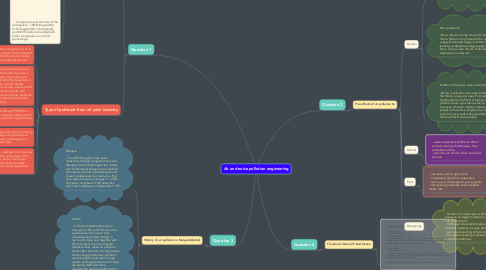
1. Question 1
1.1. Air pollution composition
1.1.1. Air pollution defined as the of one or contaminants or combinations in such quantities.
1.1.2. Tend to be injurious to human, animal or plant life or property, or which unreasonably interferes with the comfortable enjoyment of life or property or conduct of business.
1.1.3. Composition and structure of the atmosphere : 78% Nitrogen(N2), 21% Oxygen(O2), 1% Argon(Ar), and 0.03% Carbon Dioxide(CO2). Other inert gases are in small percentage.
1.2. Type of pollutant from oil palm industry
1.2.1. In current situation the presence of oil palm wastes has created a major disposal problem, thus, affect the environmental and created a major disposal problem.
1.2.2. The oil palm industry has always been linked to the environment because it is a land intensive industry. Any unplanned development will lead to the degradation of the forest systems, loss of habitats including plants and animals, extreme land degradation and pollution (water and airborne) due to the use of large quantities of pesticides and herbicides required to maintain the plantation.
1.2.3. Palm oil mill effluent (POME) is a by-product of the palm industry and it releases large amounts of greenhouse gases (GHGs).
1.2.4. Water systems are also contaminated by POME if it is released into nonstandard ponds or rivers where it endangers the lives of fish and water fowl.
1.2.5. On the input side, crude palm oil mills use large quantities of water and energy in the production processes, and on the output side, manufacturing processes generate large quantities of solid waste, wastewater and air pollution.
2. Question 3
2.1. History of air pollution in Malaysia/Global
2.1.1. Malaysia - The 2005 Malaysian haze was a week-long choking smog-like haze over Malaysia that almost brought the central part of Peninsular Malaysia to a standstill, prompted crisis talks with Indonesia and caused widespread inconvenience. The haze was at its worst on August 11, 2005. This was a comeback of the haze crisis which last hit Malaysia in September 1997.
2.1.2. Global - In UK the Industrial Revolution during the 18th and 19th centuries was based on the use of coal. Industries were often located in towns and cities, and together with the burning of coal in homes for domestic heat, urban air pollution levels often reached very high levels. During foggy conditions, pollution levels escalated and urban smogs (smoke and fog) were formed. These disrupting traffic but more dangerously causing death rates to dramatically rise. The effects of this pollution on buildings and vegetation also became obvious. The 1875 Public Health Act contained a smoke abatement section to try and reduce smoke pollution in urban areas. - 20th century, tighter industrial controls lead to a reduction in smog pollution in urban areas. The 1926 Smoke Abatement Act was aimed at reducing smoke emissions from industrial sources, but despite the declining importance of coal as a domestic fuel, pollution from domestic sources remained significant.
3. Question 2
3.1. The effects of air pollution to
3.1.1. Human
3.1.1.1. Asthma - Breathing polluted air puts you at a higher risk for asthma and other respiratory diseases. Ozone and traffic pollutants can trigger an asthma attack, there is also emerging evidence for onset of asthma associated with exposure to pollution.
3.1.1.2. Brain problems - Brain requires a high amount of energy. Hence there is a high demand for oxygen supply. Decreased oxygen content in air leads to inadequate energy supply to the brain. There is also the risk of headaches, depression, anxiety, etc.
3.1.1.3. Irritation of the eyes, nose and throat - Being in pollution can cause irritation in the throat, lungs, and eyes. For most healthy adults, ill effects of being in pollution clear up as soon as the air quality improves. Children, elderly individuals, and people with asthma, emphysema, angina, and other lung and/or heart problems may feel the effects more acutely.
3.1.2. Animal
3.1.2.1. - causes respiratory problems. When animals inhale polluted gases, they suffocate and die. - acid rain can kill lots of fish and other animals.
3.1.3. Plant
3.1.3.1. - decrease yield in agriculture. - suppressed growth of vegetables. - leaf injury and damage to young plants. - decreased growth rate and increased death rate.
3.1.4. Belongings
3.1.4.1. - corrosion of metals due to SO2 in presence of oxygen moisture is converted into H2SO4 acid. - H2SO4 acid react with marble and other building materials to cause deterioration. - soiling and eroding of building materials. - O3 causes cracking of rubber and various electrical insulations.
4. Question 4
4.1. The Good Ozone VS Bad Ozone
4.1.1. Two layers of ozone - Stratospheric = The “Ozone Layer” = “Good Ozone” (~15-50 km) = Stratospheric ozone: Helps protect us from harmful UV radiation from the sun. Very important. When people think of ozone, man times this is what they think of. This is the “good ozone”. - Tropospheric = “Bad Ozone” (0~15 km) = Tropospheric ozone: What we’re going to talk about in more detail. This is the “bad ozone”, found at ground level that damages vegetation, human health, and economies. #All ozone is within the first 50km of the earth’s atmosphere.

